Acne is a disease familiar to most people. Most often, it first appears in adolescence and goes away after it, but can persist throughout life. For treatment, various external methods are used - proper cleansing of the skin and care for it, drying and anti-inflammatory ointments and mash, solutions and creams with antibiotics and much more (Skinoren, Baziron AS, Zinerit, Tsindol, etc.). When acne cannot be cured with local remedies, acne pills come to the rescue.
Briefly about acne
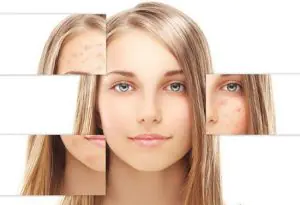
Several factors are to blame for the occurrence of acne:
- disturbed hormonal balance;
- reduced protective functions of the skin;
- infections;
- hyperkeratosis (disruption of the normal process of skin exfoliation);
- excessive activity of the sebaceous glands.
All of them lead to increased production of sebum, blockage of pores and the occurrence of an inflammatory infectious process inside them with the formation of pustules (pimples).
Some processes can be influenced using local means. Others require mandatory systemic therapy.
What tablets are used for acne
In order to influence the pathogenesis factors of acne, dermatologists use:
- hormonal drugs;
- antibiotics;
- retinoids;
- sorbents;
- probiotics;
- vitamins.
All of them should only be prescribed by a doctor due to the large number of side effects and contraindications. You can only take sorbents, probiotics and vitamins on your own.
Hormonal tablets against acne
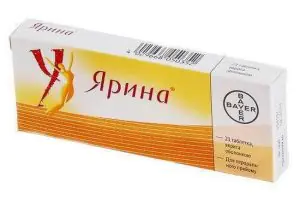
The most common cause of acne is an increased level of androgens in the blood. In order to normalize this indicator, girls and women are prescribed hormonal therapy. The method of correcting hormone levels and the specific drug is chosen by the gynecologist. In some cases, an additional consultation with an endocrinologist may be necessary.
Most often, oral contraceptives are used to treat acne from hormonal drugs:
The course lasts 3-4 months after which the hormonal status is re-evaluated. In some cases, these acne medications may be prescribed for a long period of time – 1-2 years.
Hormonal products are very effective in treating acne, as they not only normalize hormone levels, but also help reduce the secretion of sebum, as a result of which the rashes decrease and the skin clears.
Antibacterial agents against acne
Since purulent formations on the skin, which include acne, are provoked by various infections, antibiotics for acne in adults are used very often. They are included in local acne treatments and prescribed in tablets.
Antibacterial treatment for acne is usually long-term – from 3 months to a year. But at the same time, the dosages are selected low, so no particular harm is caused to the body. This scheme is effective only for skin diseases.
Many patients are frightened by the need to take antibiotics for so long, since everyone knows about their harm. Therefore, it is important to understand the difference between conventional treatment with these medications and acne therapy. To cope with a skin infection, you do not need massive antibiotic therapy for a week, as with other inflammatory processes caused by bacteria. On the contrary, you need small doses, but for a long time. Then the antibiotics will have the desired effect in the skin, but will not affect other organs and systems. Therefore, there is no need to be afraid of such appointments.
Tetracycline antibiotics have proven to be most effective for acne. If there are contraindications to them or bacterial resistance is detected, then macrolides, nitrofurans, and sulfonamides are prescribed.
Tetracyclines for acne
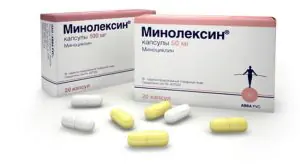
Tetracyclines include:
- Minocycline;
- Doxycycline;
- and Tetracycline itself.
In the treatment of skin diseases, Doxycycline is most often used as part of the drug Unidox Solutab. Thanks to its convenient dosage, it is enough to take this acne medicine once a day, which is important for long-term therapy - patients often forget about taking pills multiple times.
Treatment at such a low dose almost never leads to side effects. In rare cases, allergies, swelling, and skin irritations may develop.
Macrolides in the treatment of acne
This group of drugs is also often prescribed for the treatment of acne. One of its representatives, erythromycin, appears in many products for external therapy. But it is also used internally for severe acne. Perhaps this is why in recent years many cases of resistance of skin flora bacteria to erythromycin have been recorded. Therefore, other drugs from macrolides are used:
- Josamycin;
- Clarithromycin;
- Azithromycin, etc.
Josamycin (Vilprafen Solutab) is an antibiotic for acne, which is prescribed not only for acne, but also for deep infectious processes in the skin - boils, carbuncles, erysipelas.
Nitrofurans
Antibiotics of the nitrofuran series are most often prescribed when acne is accompanied by demodicosis (a disease caused by the demodex skin mite). They are equally effective against ticks and most skin infections.
The most widely used of this group is Metronidazole (Trichopol, Metrogyl). It is used both in the form of acne tablets and as part of local remedies.
Sulfonamides against acne
Sulfonamides were among the first to be used in medicine among all antibiotics. Therefore, their contraindications and side effects are best studied, and treatment with their help is safe and effective. But due to widespread use, resistance to them often arises.
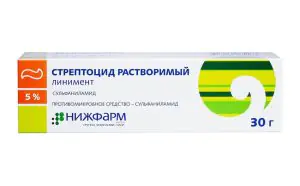
However, sulfonamides have been used with good results for acne. Dermatologists prescribe:
- Streptocide;
- Sulfamethoxazole;
- Trimetaprim et al.
These anti-acne tablets should be taken during or immediately after meals, as otherwise they can provoke stomach discomfort (nausea, heartburn, abdominal pain). Additionally, it is recommended to drink more water.
Sulfonamides increase the skin's sensitivity to the sun, so you should use sunscreen during treatment.
Systemic retinoids
This group of drugs is the most effective for acne, but also the most dangerous in terms of side effects.
In Russia, the following systemic retinoids are used:
The pronounced result from their use is explained by the ability to reduce the secretion of sebum, and over time even lead to atrophy of the sebaceous glands. Due to this, blockage of the skin ducts is eliminated and rashes are reduced. Bacteria are deprived of their nutrient medium. Skin keratinization processes are normalized. All this leads to the disappearance of acne, the face is cleansed, looks fresh and well-groomed.
But despite their high effectiveness, these acne treatment tablets are used with caution and only when other measures are ineffective due to many adverse reactions.
To avoid relapses, Roaccutane and its analogues are prescribed for a long period. In parallel with skin treatment, side effects from other organs may develop - pain in muscles and joints, visual impairment, liver pathologies, headaches, problems with the gastrointestinal tract, etc. Severe dryness of the mucous membranes is almost always observed. Most patients complain of cheilitis (dry lips up to painful cracks). Therefore, these drugs should never be taken independently.
Pregnant women should absolutely not take retinoids, as they have a pronounced teratogenic effect (cause deformities in the fetus). To prevent this, double contraception is recommended for all girls and women during the treatment period.
Only a dermatologist should prescribe systemic retinoids after conducting all the necessary tests. Subsequently, tests are repeated throughout the treatment to monitor the condition of the internal organs. Dosages during therapy can also be adjusted to select the maximum safe dose while maintaining the therapeutic effect.
Sorbents in the treatment of acne
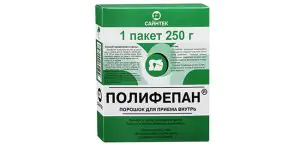
Toxin-binding drugs have also begun to be used in the treatment of acne in recent years. These include sorbents:
- Polysorb;
- Enterosgel;
- Polypephane;
- Activated carbon.
Their use leads to cleansing of the body and increasing its resistance to infections, which contributes to the disappearance of acne.
Most often, sorbents are prescribed together with probiotics. First, they take drugs from the first group for at least a month, then from the second. That is, they first help the body get rid of toxins and pathogens, then normalize healthy microflora. Together, these processes help improve immunity and local protection against infections.
Probiotics
Despite the fact that lactobacilli and bifidobacteria are found in the intestines, they actively help fight for the beauty and purity of the skin, as they provide immune protective properties. Therefore, in the treatment of acne, an additional course of probiotics is prescribed after a course of enterosorbents.
The list of popular drugs from this group includes:
- Bifiform;
- Acylact;
- Biphilis;
- Probifor;
- Bifidum bacterin, etc.
They must be taken for a long time - at least a month. And to consolidate the effect, it is recommended to continue treatment for up to three months.
Vitamin therapy in the treatment of acne

Vitamins and microelements have a significant impact on the appearance and condition of the skin. With acne, a deficiency of vitamins B, A, E and C is often detected. They should be taken when acne appears. You can buy tablets and capsules containing only one element. But it is more convenient to choose complex drugs. They not only contain all the substances necessary for the body, but are also selected in the optimal quantity and ratio.
In pharmacies you can find vitamin complexes specially created to maintain healthy skin or treat acne.
You also need to monitor the correctness and adequacy of your diet, since a person receives many vitamins and microelements from food. For acne, the diet should contain a lot of fresh fruits and vegetables, nuts, fish, lean meats, and vegetable oils (they contain a lot of healthy fatty acids).
Anti-acne tablets are used when local treatment is ineffective or as an addition to it to consolidate the result. The choice of a specific drug depends on the form of acne, the degree of its neglect and the individual characteristics of the patient. You should not experiment with self-medication, since most systemic remedies have many contraindications and serious side effects. It is better to immediately consult a cosmetologist or dermatologist and entrust the choice of therapy to a competent specialist.
Video about acne
Skin problems bother many people of all ages. A common disease is acne. It is expressed in the presence of rashes and inflammatory elements on the skin.
The occurrence of acne is due to various reasons and has a specific development mechanism. Treatment is carried out in several ways, taking into account all factors and individual characteristics of the body.
What is acne on the skin of the face
Acne is an inflammatory skin disease. It appears in the form of acne, pimples, comedones and purulent formations. The rashes spread over various parts of the face, but most often in the T-zone.
Reasons for appearance
The condition of the skin can be used to judge a person's health. The presence of inflammatory elements indicates diseases and disorders in the body. Another factor influencing the appearance of acne is inadequate or irregular cleansing and the use of low-quality cosmetics.
Acne appears for the following reasons:
- excessive activity of the sebaceous glands;
- enlarged pores;
- epithelial keratosis inside the follicle;
- hormonal imbalances;
- puberty;
- premenstrual period;
- imbalance of the autonomic nervous system;
- changes in the composition of sebum;
- stress, depression, anxiety, anxiety;
- decline in immunity;
- heredity;
- using cosmetics that are not suitable for your skin type;
- gastrointestinal diseases;
- dysfunction of the thyroid gland;
- lack of vitamins in the body;
- excessive exposure to the sun and excessive visits to the solarium;
- high humidity and hot climate;
- skin dehydration;
- improper or unbalanced diet;
- alcohol and smoking abuse.
Development mechanism - 4 factors
Acne is the result of certain disorders in the body. There are 4 factors that cause skin problems:
- Excessive secretion of sebum with a subsequent decrease in its bactericidal properties and changes in composition.
- Thickening of the stratum corneum of the skin inside the hair follicles. The result is a blockage of a protein called keratin. This is how the body reacts to local irritation.
- Active proliferation of propionobacteria acne due to the formation of sebaceous-horn plugs.
- Inflammation as a reaction to the activity of microorganisms.
Types of inflammation on the skin
There are several types of skin inflammation:
- Acne is the result of blocked sebaceous ducts.
- Acne is an inflammation of the sebaceous glands and hair follicles with the subsequent formation of blackheads and nodules.
- Papules are subcutaneous inflammatory elements. They occur when secretions accumulate in the comedone, followed by tissue compression. As a rule, it comes to the formation of pus. In some cases they resolve before this point.
- Pustules are a rash in the form of small balls with purulent contents.
- Nodules are a type of papule. They have a purple tint and reach several centimeters in diameter.
- Cysts are large inflammatory elements with purulent filling. They leave traces in the form of scars, pigmentation, spots and enlarged pores;
- Comedones are plugs in the ducts of the sebaceous glands. They arise due to the accumulation or blockage of the mouths of the hair follicles by sebum. They are whiteheads (closed comedones) and blackheads (open comedones).
Inflammatory, non-inflammatory and post-inflammatory forms of acne
Each form of acne has its own distinctive features:
- non-inflammatory - closed comedones, open comedones, nodules;
- inflammatory - follicular papules, pustules, nodes, draining sinuses;
- post-inflammatory - cysts, scars (atrophic, hypertrophic, keloid), spots (vascular, hyperpigmented, hypopigmented).
Classification by age
At every age, certain types of acne occur. There is the following classification:
- Newborn acne in the form of closed comedones. The reason for its appearance is the entry of maternal sex hormones into the baby’s blood. It goes away without a trace after a few weeks if you follow the rules of hygiene.
- Infant acne in the form of papules and inflammatory elements. The reason for the appearance is an excess of testosterone levels in plasma.
- Teenage and youthful acne in the form of papules and pustules with purulent contents. The reason for its appearance is puberty.
- Adult (later) acne occurs in men and women after 30 years of age. The reason for its appearance is the presence of serious diseases, including hormonal ones.
Four degrees
The degree is determined by the external signs of the disease. The number of comedones and various inflammatory elements is taken into account. There are 4 degrees in total:
- Easy. Up to 10 blackheads and comedones.
- Average. From 10 to 30 comedones and papules with purulent contents.
- Heavy. A large number of comedones, several dozen papules and a small number of pustules.
- Very heavy. The skin is affected by papules and pustules. There are more than 5 knots. I am worried about pain.
Types of treatment depending on the type of acne
Acne treatment is selected after preliminary determination of the type of inflammatory elements. Carried out under the supervision of a specialist.
Only - open and closed acne
Treatment is based on the use of retinoids, Azelaic acid or salicylic acid. To achieve the best result, additional medications may be prescribed.
Mixed form - acne and pimples
One of the following complexes is prescribed:
- retinoid and benzene peroxide;
- retinoid and antibiotic;
- retinode, benzene peroxide and antibiotic;
- azelaic acid and benzene peroxide;
- azelaic acid and antibiotic.
If the effect is mild, a retinoid and an oral antibiotic are additionally prescribed.
Only acne
Treatment is based on the use of a drug with benzene peroxide. If the effect is insufficient, other means are prescribed:
- antibiotic gel;
- a combination drug of benzoyl peroxide and antibiotic.
If the desired result is not achieved, an additional course of oral antibiotic is prescribed.
Cystic and nodular forms of acne
To treat such forms, oral antibiotics are used. Additionally, one of the complexes of drugs is used to combat mixed forms of acne.
Folk remedies for the treatment of acne on the face
Traditional methods have proven effective in the fight against acne. Natural remedies help relieve inflammation and reduce the number of rashes.
Homemade cosmetics can be stored in the refrigerator for no more than 30 days. Immediately after cooking, place in a dark container with a tight-fitting lid.
Masks
They soothe inflammation, relieve redness and have a drying effect. After use, be sure to moisturize the skin.
Take 2 tbsp. l. black clay. Dilute with chamomile or calendula decoction to a mushy consistency. Apply to face and leave for 10-15 minutes. Repeat 2 times a week.
Take 2 tbsp. l. crushed oatmeal flakes. Mix with 1 tbsp. l. kefir Leave for five minutes. Apply to skin and leave for 10 minutes. Repeat 2-3 times a week.
Peel the skin from the tomato and mash thoroughly with a fork. Add 1 tsp. soda Apply to skin and leave for 20-25 minutes. Repeat once a week.
Used as the main treatment for acne. Apply morning and evening or once a day.
- Take 3 tbsp. l. olive oil, 1 tbsp. l. shea butter and 2 tsp. beeswax. Melt in a water bath. Add 2 capsules of vitamin E and lecithin to the tip of a knife. Mix 1 tbsp. l. rose water and 1 tbsp. l. aloe juice Pour into the butter mixture and stir.
- Pour 100 ml. boiling water 2 tsp. dry chamomile leaves and 1 tbsp. l. birch buds. Cool. Melt 1 tsp in a water bath. beeswax and 1 tbsp. l. olive oil. Add 3 drops of vitamin A, 1 tbsp. l. butter and strained herbal decoction. Leave on the stove for a minute, stirring constantly. Remove from heat and cool.
- Mix 1 tbsp. l. honey, 1-2 drops of iodine, 1 tsp. Vaseline and 1 tbsp. l. castor oil.
Lotions
Cleanse the skin and help relieve inflammation. They have a tonic effect. To achieve good results, apply daily morning and evening.
- Pour 1 tbsp. l. dry wormwood with a glass of boiling water. Leave for half an hour. Strain. Add 30 ml. freshly squeezed viburnum juice and 1 tsp. salt.
- Mix ½ cup of rose water, a quarter cup of still mineral water, 1 tsp. apple cider vinegar, ½ tbsp. l. sweet almond oil, 5 drops tea tree oil, 2 drops lavender oil. Leave for 4 days. Shake before use.
- Take 1 tbsp. l. apple cider vinegar, 1 tbsp. l. water, 5 drops each of geranium, palmarosa and tea tree essential oils, 1-2 ml. polysorbate 80. Mix and leave for 2 weeks. Shake before use.
Tinctures
They have a pronounced anti-inflammatory effect.
- Take 1 tsp. St. John's wort, wormwood and hops. Pour 250 ml. boiling water, cover and cool. Strain the broth and add half a glass of vodka and 2 tbsp. l. apple cider vinegar. Wipe your face 2 times a day, moving along the massage lines. Rinse off 15 minutes after application.
- Hold the onion over steam for 5-10 minutes and squeeze out the juice. Mix onion juice and calendula in a 1:1 ratio. Apply to a cotton pad and apply to the skin. Leave on for 10 minutes, then rinse off. Repeat 3 times a day.
- Mix alcohol tincture of propolis and water in a 1:1 ratio. Wipe your face daily before going to bed.
What medications are suitable for treating acne
Medication is another option for treating acne. Special products can be purchased at the pharmacy. However, many of them have contraindications, so it is recommended to consult a specialist.
Pills: hormones or antibiotics?
Prescribed by the attending physician after a preliminary examination. It is necessary to correctly determine the type of inflammation, the degree of acne and the form of the disease. The dosage is selected individually.
The following types of tablets are most often prescribed for the treatment of acne:
- Antibiotics - erythromycin, levomycin, metronidazole, tetracycline, doxycycline and others.
Each drug has a whole range of contraindications. For example, pregnancy, breastfeeding, individual intolerance to the components of the composition.
- Hormonal - Jess, Yarina, Janine, Diane, Median and others.
They have contraindications such as pregnancy, breastfeeding, individual intolerance, diseases of the gastrointestinal tract, liver, kidneys and others.
- Retinoids. Roaccutane is considered the most popular drug in this group.
The drug has many contraindications and side effects, so it is prescribed only after examination. It has such contraindications as children under 12 years of age, pregnancy, planning pregnancy, breastfeeding, hypervitaminosis A, individual intolerance and others.
Creams
Used to treat acne at different stages. The most popular drugs:
- Bepanten is a universal remedy for skin treatment.
Helps not only relieve inflammation, but also eliminate irritation, dryness and flaking. Contraindication: hypersensitivity to the components of the composition.
- Boro Plus is a cream for the treatment of acne and post-acne.
Accelerates regeneration and has an antiseptic effect. Contraindication: individual intolerance to the components of the composition.
- Levomekol is a remedy for the treatment of ulcers.
Relieves inflammation and swelling, draws pus to the surface. With prolonged use, addiction occurs. Contraindication: allergy to chloramphenicol, methyluracil, ethylene glycol.
They are considered an alternative to creams and ointments. They have a light texture, so they are quickly absorbed and do not leave any grease on the skin. The following drugs help in the treatment of acne:
- Effezel is a gel for the treatment of acne at different stages.
Has antibacterial and anti-inflammatory effects. Contraindication: hypersensitivity to any component of the composition.
- Dalatsin is a universal gel for the treatment of various types of acne.
Used in courses of no more than 5 weeks. Used only as prescribed by a specialist in the absence of contraindications.
- Metrogyl is a gel for the treatment and prevention of rashes.
Often prescribed in combination with other drugs. Has various contraindications. For example, age up to 12 years, pregnancy, lactation and others.
Vitamins
Help speed up the acne treatment process. However, in case of overdose, a reverse reaction is possible. The following vitamins are used:
- retinol (A);
- tocopherol (E);
- L-isomer of ascorbic acid (C);
- niacin (nicotinic acid, PP);
- B vitamins.
They vary by type. Anti-inflammatory agents are popular. They have antiseptic and bactericidal properties. They are characterized by low cost, minimal number of contraindications and high efficiency. Zinc, sulfur, heparin and ichthyol ointments have proven themselves well.
Antimicrobial agents are also in demand. Such ointments inhibit the growth of pathogenic bacteria and prevent the spread of infection. Among them are Skinoren, Kuriosin, Cynovit.
These drugs are used exclusively in courses and have contraindications.
Another type is hormonal ointments. Used only as prescribed by a doctor. The effect is achieved in a short time, however, addiction occurs just as quickly with a subsequent decrease in effectiveness. Advantan, Sinaflan, and Fluorocort are used to treat acne.
Salon treatments for treatment
Modern cosmetology offers a number of procedures to treat problem skin. The most popular are:
- Mesotherapy - injections of therapeutic meso-cocktails.
The composition is selected individually. Antibacterial and restorative substances, as well as vitamins, are used.
- Ozone therapy - ozone injections.
Injection of a mixture of gases - ozone and oxygen - under the skin. It has an antimicrobial, sebum-regulating and healing effect.
- Peeling is the removal of the stratum corneum of the skin.
In the fight for clear skin, chemical, glycolic and multi-acid peels are used.
- Magnetotherapy is the effect of various magnetic fields on the body.
Promotes the resorption of nodules and ulcers. Helps eliminate acne and scars.
- Darsonvalization is the effect of alternating pulse currents of high voltage and frequency.
Has anti-inflammatory and sebum-regulating effects. Promotes narrowing of pores, healing of scars, scars and post-acne.
Recommendations from a dermatologist for acne treatment can be found in the video.
Acne treatment at home
Caring for problem skin at home will be effective if you follow the following rules:
- regular skin cleansing morning and evening;
- treatment of problem areas with tinctures, ointments, gels and other anti-inflammatory agents;
- selection of a daily complex, including cleanser, toner and cream according to skin type;
- additional care in the form of masks.
How to fight acne with diet
Acne is often associated with poor diet. It is worth reviewing your diet and including foods that contain:
- fiber - fruits and vegetables;
- proteins - lean meats, fish, poultry, seafood, dairy and fermented milk products;
- vitamin A - spinach, carrots, cucumbers, black currants, apricots, sorrel, olive oil, beef liver;
- vitamin E - pistachios, almonds, peanuts, walnuts;
- vitamin B - buckwheat, wheat cereal, legumes, cabbage, cheeses;
- omega acids - fish oil, flax seeds;
- zinc - stewed beef, asparagus, liver, bran.
Some foods will have to be excluded from the diet. Otherwise, the diet will not give the desired result.
- bakery products made from fine flour;
- fast food;
- sweets;
- hot, salty, spicy;
- fatty food;
- smoked meats;
- canned food;
- fatty meat and lard;
- carbonated drinks;
- strong tea and coffee;
- alcohol.
Tips for caring for problem skin
Regular cleansing is the key to clean and healthy skin. However, the procedures must be carried out correctly. While washing, you need to make gentle massage movements with the pads. It is advisable to foam the cleanser in your hands in advance. Brushes and hard sponges can damage the skin and spread infection, so you will have to discard them.
It is better to wipe your face with disposable paper napkins without dyes or fragrances. You can also have a separate face towel, if you can change it to a clean one every 2-3 days.
After cleansing, try to wipe your face with a cotton pad moistened with toner. It is advisable to use a product with an anti-inflammatory complex. It is worth considering that the cream will be absorbed better if you apply it to slightly damp skin from the toner. The active components will penetrate into the deep layers of the epidermis along with water.
How to get rid of acne marks on your face
After acne treatment, marks remain on the skin. Among folk methods, parsley decoction is popular.
The plant is famous for its whitening properties, so it helps to quickly get rid of post-acne.
You can also try pharmaceutical products:
- Panthenol;
- Contactubex;
- Rescuer;
- salicylic alcohol;
- hydrogen peroxide;
- Sulfuric ointment.
Preventive measures to prevent acne
Any remedy gives a temporary effect in the absence of proper care. Recurrence of acne can be avoided if you continue to monitor your skin after completing therapy. This will help:
- application of cosmetics according to skin type;
- using cream for acne-prone skin;
- using acne masks 1-2 times a week;
- change the pillowcase every 2-3 days;
- providing a separate towel for the face;
- undergoing routine examinations to monitor health status;
- selection of cosmetics without artificial colors and flavors;
- diet;
- refusal of hats made of synthetic materials.
Acne can occur at any age for various reasons. Most often, this is a regular occurrence, so you should take this problem seriously. There are several methods for getting rid of acne and their consequences. To understand how to treat acne on the face, you need to consider each specific case in more detail. The opinion of specialists on this issue is also necessary.
Causes of acne on the face
Before you begin treatment for facial acne, you should understand the origin of the disease. There are many factors that affect the condition of the skin. Let's look at the main causes of acne:
- hormonal changes or disruptions associated with changes in the body during adolescence, as well as during pregnancy, menstruation, menopause, and various pathologies of the reproductive system;
- deviations in the functioning of the gastrointestinal tract, leading to metabolic disorders;
- eating large amounts of sweet and fatty foods, as well as frequent drinking of alcoholic and carbonated drinks. The presence of harmful or toxic substances in the blood leads to skin rashes;
- genetic predisposition. If there are relatives in the family with this problem, there is a possibility of inheriting it;
- disorders in the endocrine system. The appearance of acne is the main symptom of this pathology;
- insufficient or improper skin hygiene. It consists of neglecting regular cleansing and care of the epidermis;
- low-quality decorative cosmetics that clog pores. Such products may contain heavy metals and other harmful chemical components that have a negative effect on the body;
- excessive exposure to the sun provokes increased activity of the sebaceous glands, producing excessive amounts of sebum;
- poor immunity unable to resist infections;
- lack of vitamins and microelements in the diet;
- Stressful and depressive states inhibit the overall activity of the body and its protective functions.
The causes and treatment of acne are determined by a dermatologist after undergoing an examination (photo below).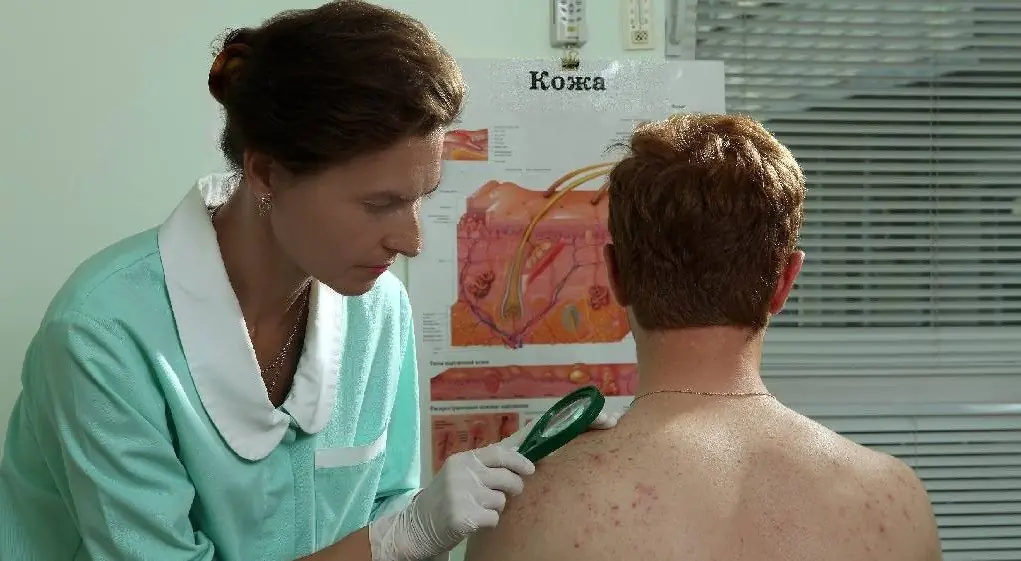
In addition to a visual examination, it is recommended to take a biochemical blood test to detect the pathogen that provoked the inflammation. You may need to do an ultrasound if your acne is associated with internal pathology.
Treatment of acne on the face: drugs
Getting rid of acne is a labor-intensive process and practically cannot be done without the use of special medications. Since inflammation occurs against the background of infection, tablets and external agents are aimed at eliminating it. These include antibacterial and natural medicines.
Antibiotics
Antibiotics for facial acne are prescribed in severe cases of the disease, when other medications do not give the desired result. Despite the high effectiveness of antibacterial drugs, such therapy can provoke a disruption of the intestinal microflora. Therefore, they must be taken with caution; an acne treatment regimen drawn up by a doctor is required.
These medications are available for local use (gels, ointments, creams) and internal effects on the source of infection.
Antibiotics for external use:
Erythromycin – an ointment characterized by a wide spectrum of action, affects the synthesis of proteins of pathogenic microorganisms, thereby preventing their reproduction.
- resolves pus inside pimples, reduces inflammation and redness, positive dynamics are observed on the fifth day;
- has a long-lasting effect; after completing the course, acne does not appear on the face for a long time;
- approved for use by people who have an allergic reaction to penicillin;
- Contraindications include age under ten years, liver and kidney pathologies.
Skinoren – produced as a gel or cream with antibacterial, anti-inflammatory, softening effects.
- intended as a remedy for acne, increased pigmentation, seborrheic dermatitis, rosacea;
- the active substance (azelaic acid) enters the deep layers of the dermis, providing healing properties;
- if you follow a long course, the effectiveness of the gel and ointment will be at the same level, and the result will last a long time;
- Not recommended for people with hypersensitive skin prone to irritation.
Differin - a gel that ensures proper metabolism in the skin, protects the epidermis from external negative influences.
- copes with minor acne, can overcome severe acne only in combination with other drugs;
- affects the production of sebum, reduces oiliness. Thanks to this effect, the pores become free, the number of inflammations is reduced;
- during therapy with this drug, it is not advisable to stay in the open sun for a long time and use products containing drying components (zinc, alcohol, salicylic acid, etc.);
- prohibited if you are allergic to the components of the medicine; apply with caution for seborrhea and dermatitis.
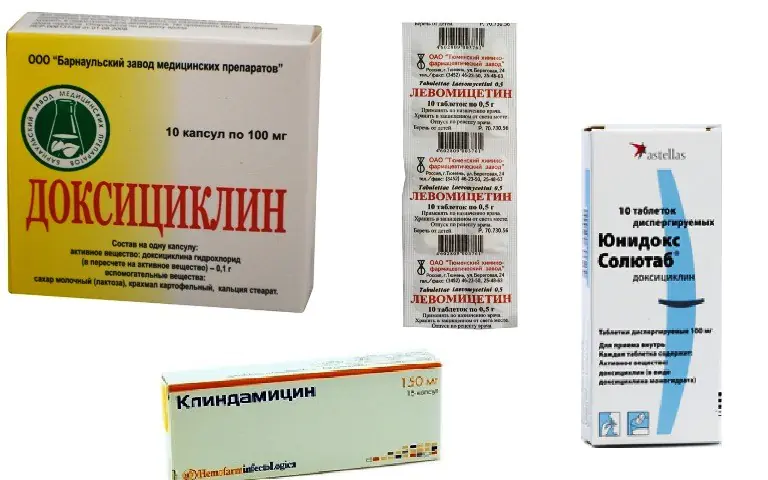
Antibiotics for internal use:
Josamycin – a drug that can prevent protein synthesis in bacterial organisms, thereby destroying their activity.
- fights almost all pathogens that cause acne;
- take two tablets a day for a month. To maintain the result, continue to take one tablet for another eight weeks;
- It is better not to combine this medicine simultaneously with contraceptives, as it may reduce the effect of the latter;
- approved for use in children over 14 years of age, not recommended if there are chronic liver problems and during breastfeeding.
Azithromycin – a medicine aimed at destroying a large number of harmful microorganisms that cause inflammation and acne.
- prescribed for many infectious diseases, capable of destroying most pathogens;
- an effective remedy for facial acne, erysipelas, dermatitis;
- A convenient course of treatment is three days. Take one tablet a day;
- It is prohibited for people suffering from serious kidney damage, children under twelve years of age and nursing women.
Doxycyline – an antibiotic that stops the spread of bacteria by disrupting their synthesis.
- eliminates rashes and inflammation in a short time, having a detrimental effect on anaerobic and aerobic microorganisms;
- is able to get rid of infections that have arisen in different parts of the body;
- treatment of acne on the face requires a twelve-week course;
- should not be used by people with anemia, fungal diseases, or circulatory problems.
Most often, treatment of facial acne with antibiotics is recommended for patients whose rashes are chronic. These drugs can eliminate the exacerbation, but without proper care and compliance with preventive measures, the effect will be temporary.
Homeopathy treatment
Another common option for treating acne on the face is homeopathy therapy. It takes place in two stages. First, symptomatic signs are removed by taking low-concentrated medications. Then the specialist individually selects a medication that can activate the body’s defense systems and permanently overcome the troubling problem. These include:
Belladonna Plus – a medicine that affects the human central nervous system and also has a powerful anti-inflammatory effect.
- helps cope with red rashes on the cheekbones and cheeks, cure mild seborrhea;
- combined with other drugs, therefore often prescribed in combination;
- has no side effects, but during pregnancy and breastfeeding it is better to refrain from using it;
- The recommended dosage is one drop of extract per 30 milliliters of liquid.
Pulsatilla – a homeopathic remedy based on the herb meadow lumbago.
- gives an effect if the culprit of acne is the abuse of sweet and fatty foods;
- stimulates the functioning of your own immune system;
- in high concentrations causes allergies in the form of a rash or disruption of the digestive system;
- Suitable for light-eyed and fair-haired girls with pale skin.
Silicea – silicic acid solution. Release form: tincture or granules.
- copes well with inflammatory processes of various nature;
- not only fights acne, but also removes post-acne;
- for skin diseases, Silicea 30 is suitable;
- prohibited if you have chronic kidney disease.
Sulfur – sulfur preparation.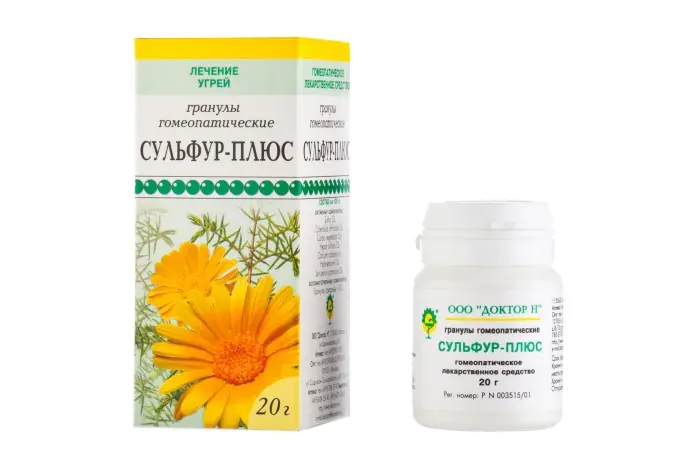
- prescribed for extensive inflammation that is not amenable to other treatment methods;
- can be taken not only during an exacerbation, but also for prevention;
- high concentrations are dangerous, as they can cause allergies in the form of suppuration;
- Gepar Sulfur 6 is recommended for resolving purulent pimples.
Homeopathy can be an independent way to remove acne on the face, or be part of a comprehensive treatment. Many note the high effectiveness of this method, exceeding even the antibacterial effect.
Folk recipes
Another option for dealing with acne is folk remedy therapy. Properly prepared products can be as effective as salon cosmetics. A wide variety of recipes allows you to choose the most optimal one.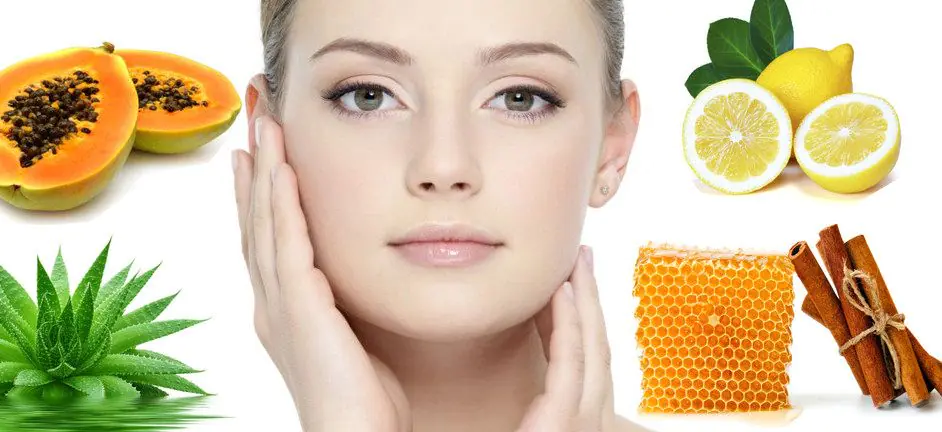
Treating facial acne at home has a number of advantages:
- all components involved in the preparation are of natural origin, so the likelihood of allergic reactions or other unpleasant consequences from use is much less;
- independent selection of ingredients guarantees a high-quality product;
- no cosmetologist is required, all procedures are carried out independently without special equipment or devices;
- This method is considered budget-friendly; the necessary components are sold in a grocery store or pharmacy. Medicinal herbs can be found in your own summer cottage or forest.
Let's present a few simple recipes that you can prepare yourself at home:
- Green tea lotion – recommended for oily skin affected by inflammatory lesions. Relieves redness and soothes.
A strong tea brew is prepared from high quality leaves. Let stand until completely cooled, then add lemon juice (in equal proportions). The resulting mixture is used to treat the affected areas three times a day.
- Aloe compress – effectively draws out internal acne, relieves pain and discomfort.
A medium-sized leaf is cleared of thorns and cut into thin slices. They are placed on nascent or already formed ulcers and fixed with adhesive tape. Leave it overnight, and in the morning remove any remaining blackheads with a cotton pad.
- Wormwood infusion – treats inflammation, improves the structure of the skin.
Two tablespoons of the crushed plant are poured into glasses of boiling water. Leave to infuse for three hours in a dark place. Treat the skin with it as often as possible (three times a day or more).
- Calendula solution – has a wound-healing effect, eliminates traces of rashes and age spots.
You can buy calendula tincture (on flowers) at the pharmacy. A teaspoon is mixed with a glass of water and a spoon of honey. A napkin or cloth is soaked in this solution and applied to the face for half an hour. Afterwards wash with clean water.
- Protein mask– helps get rid of rashes in the T-zone, temples, blackheads on the nose and chin.
The white is separated from the yolk and transferred to a separate bowl. Add a teaspoon of lemon juice. Beat the mixture with a mixer until a rich foam forms. Apply successively to the facial skin in three layers, waiting until the mask dries. Then rinse everything off thoroughly and apply a nourishing cream.
Rules for caring for problem skin
In addition to selecting a method and means to treat acne on the face, it is necessary to carry out certain hygiene measures.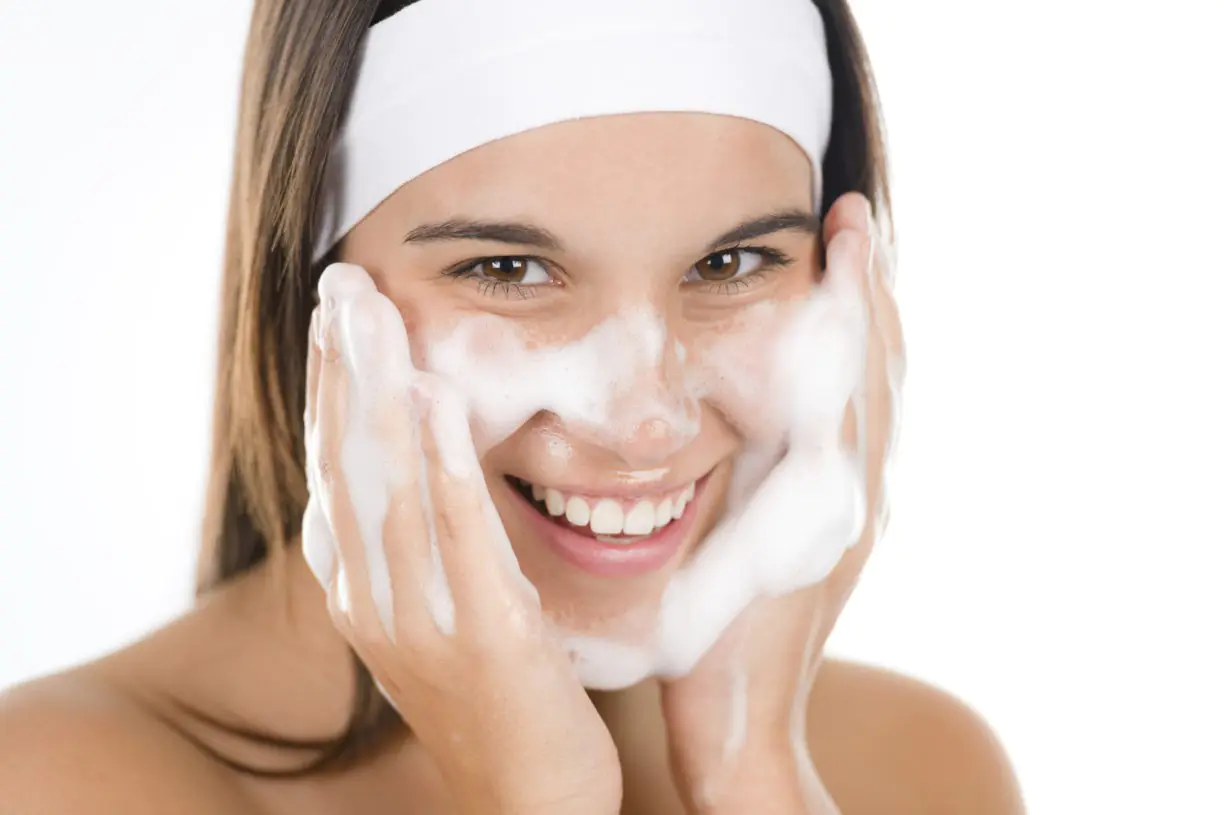
Proper facial skin care consists of the following rules:
- Do not use ordinary soap, which tightens the skin. This provokes the active work of the sebaceous glands, and more subcutaneous fat is released. There are special products for cleansing problem skin;
- regularly use scrubs or peels. Such procedures renew the skin, remove blackheads;
- To avoid infection when applying a cosmetic product with your hands, it is better to purchase a special brush;
- You should wash with clean water, or better yet, with herbal decoctions. The towel must be individual and used only for the face;
- After cleansing, do not rub the problem skin, just blot it;
- It is not recommended to squeeze out mature pimples, as there is a high risk of bacteria getting into the wound and causing an unsightly scar in the future;
- if the inflammation is very severe, it is better to periodically visit a beauty salon to correct this problem and be sure to consult a dermatologist.
Reviews
Alena, 19 years old:
I have been asking myself the question of how to get rid of acne on my face for several years now. Purulent pimples on my cheeks and forehead gave me no rest. I tried using Erythromycin ointment. I applied it to mature rashes before going to bed. The next morning, all the contents of the eel disappeared, and a dried crust remained. The ointment cannot cope with incipient inflammations; you have to wait until the pimple matures. But I’m still happy with the result, especially for such a low price.
Love 20 years:
I take Pulsatilla 6 in combination with hormonal (birth control) pills. The acne disappeared quickly, this regimen is the most optimal for me. Taking these drugs separately did not give such a result; only complex therapy helped.
Irina 28 years old:
Numerous positive reviews speak about the benefits of aloe for problem skin. I have tried many recipes from this plant. I made masks, lotions, wiped my face with juice. What I liked the most was the leaf compress. In the evening I apply it to the pustule, and in the morning there is no pimple left, only a small film.
In modern medicine and cosmetology, many ways to treat acne have been invented. Early diagnosis and the right method will help get rid of acne in a short time. Maintaining a healthy lifestyle and a balanced diet will prevent this problem from returning again. Clean skin is not only a well-groomed appearance, but also an indicator of health.



